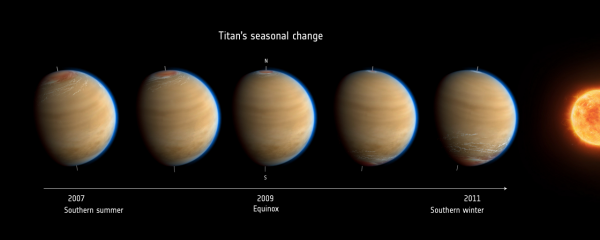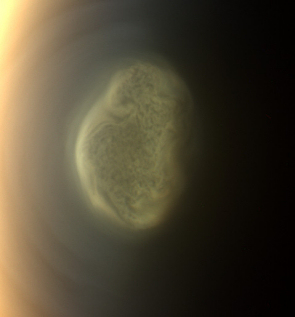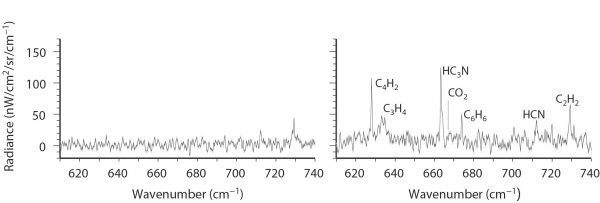Cassini reveals Titan's atmosphere in reverse
28 November 2012
With winter fast approaching, everyone living in Earth's northern hemisphere is well aware that major atmospheric variations are associated with the changing seasons. Now new observations made by the international Cassini spacecraft confirm that an even more dramatic atmospheric reversal takes place as the seasons shift on Saturn's giant moon Titan.In some ways, Titan resembles a primitive, deep-frozen Earth. The second largest satellite in the Solar System has a thick, nitrogen-rich atmosphere which is even denser than Earth's. However, since it is almost 10 times Earth's distance from the Sun, it has a much lower surface temperature, about -178 degrees Celsius. This temperature hardly changes from season to season.
On Earth, seasonal changes occur because the planet's axis of rotation is inclined to the plane of its orbit. In winter, the north pole points away from the Sun; in summer the north pole points towards the Sun. Similar variations occur on Saturn, which has a slightly larger tilt than Earth. Since Titan orbits above the giant planet's equator, it, too, experiences major seasonal changes in the amount of sunlight each pole receives.
 |
| Titan's changing seasons. Credit: ESA - C. Carreau |
On the other hand, each season on Titan (and Saturn) is unusually long: about 7.5 Earth years. This is because Saturn takes more than 29 years to complete one orbit of the Sun, which means that most seasonal changes on Saturn and Titan are expected to be very slow.
Although the distribution of high and low surface temperatures shifts with the seasons on Earth, the planet's overall pattern of atmospheric circulation remains the same, with rising air near the equator, two Hadley cells in the tropical regions, plus mid-latitude and polar cells of circulating air at higher latitudes.
On Titan, the circulation is much simpler. In the lower atmosphere there may be three, or even fewer, cells compared to Earth's six, and higher up there is a single, global, Hadley cell in which gas flows directly from one pole to the other. This large cell is driven by upwelling of warmer air in the summer hemisphere and subsidence in the winter hemisphere.
Gas swirls around the winter pole as it sinks toward the surface, resembling water drawn into a giant sink hole. This global circulation switches direction as the winter pole moves from prolonged darkness into extended sunlight.
Titan's unusual circulation was confirmed by measurements of temperature and trace gas abundance made during the northern winter by instruments on board Cassini. However, although numerical models can reproduce conditions in the lower atmosphere – the troposphere - very well, they are not as successful in explaining the observed temperatures, composition and winds in the middle atmosphere.
Until now, the top of the middle atmosphere's circulation was thought to lie at an altitude of 450-500 km, where there is a layer of haze that appears separated from the main haze deck. This "detached" haze was thought to be due to a combination of peak haze production and transport by the upper branch of the global circulation. However, a new study by an international team of scientists indicates that this picture needs to be revised. Their paper is published in the journal Nature.
The team used Cassini's Composite Infrared Spectrometer (CIRS) to observe Titan's atmosphere after the equinox in August 2009, when the northern winter transitioned to spring. To their surprise, the data revealed some very rapid changes in atmospheric temperature and composition.
South polar warming at altitudes above 300 km suggested that subsidence over the pole began just after the equinox. The observed temperature structure implied that the rate of subsidence was 0.5 mm/s in early 2010, quickly increasing to 1.5 mm/s by June 2010.
 |
| Vortex close up. Credit: NASA/JPL-Caltech/Space Science Institute |
"The circulation of the middle atmosphere began to switch direction over a period of only 6 months, or 12 Titan days," said Nicholas Teanby, lead author of the paper and a Research Fellow at the School of Earth Sciences, University of Bristol, UK.
"The increase in temperature above 300 km was due to adiabatic heating, which resulted from the upper atmosphere air sinking and being compressed. In contrast, we found that the atmosphere cooled by 20 degrees Celsius at altitudes of 150-300 km, probably due to radiative cooling from the lower atmosphere, which is now experiencing reduced solar heating. This suggested that subsidence had not yet extended to lower levels."
The team also found very rapid changes in the composition of the upper atmosphere, with evidence of large increases in trace gas abundances over the south pole between late 2010 and mid-2011. These changes were linked with the onset of atmospheric subsidence after the equinox.
"Solar UV and impacts by high energy electrons lead to photochemical reactions in Titan's atmosphere at altitudes above 500 km, producing trace compounds such as HCN (hydrogen cyanide) and HC3N (cyanoacetylene)," explained Nicholas Teanby.
"We were able to detect increases in the abundances of five trace gases, which were being transported into the lower atmosphere and becoming more concentrated as a result of the slow sinking of the atmosphere at the south pole.
 |
| Changes in trace gas abundances over Titan's south pole. Credit: ESA |
"The observed increases in both the temperature and abundance of trace gases are consistent with south polar subsidence above 300 km for the post-equinox period. This is the first direct evidence of a reversal in the direction of the atmospheric circulation in the middle atmosphere."
In tracing the distribution of a few select gases during this period, they also found that the circulation of Titan's thick atmosphere must extend to at least 600 km – considerably higher than previously believed. The data indicate that complex chemical production is occurring well above the visible "detached" haze, which was previously believed to be due to accumulation of particles at the top of the middle atmosphere's circulation cell.
"The detached haze layer may be evidence of an alternative theory in which small haze particles combine into larger, but more transparent, clumped aggregates that eventually descend deeper into the atmosphere, giving Titan its characteristic orange appearance," said Nicholas Teanby. "The fact that we see evidence of active chemistry above 500 km would help to explain the heavy, complex molecules and ions captured at an altitude of 950 km during Cassini's close Titan flybys.
"Titan provides a natural laboratory for an Earth-like atmosphere, providing an opportunity to see the details of common atmospheric processes in slow motion. These results could eventually lead to a more complete understanding of atmospheric processes on Earth, other planets, and the many exoplanetary systems now being discovered."
"Titan's winter pole is not observable from the Earth, since the orbital geometry means it is always pointing away from Earth," said Nicolas Altobelli, ESA's Cassini project scientist. "However, Cassini is providing scientists with a unique opportunity to witness such polar changes for the first time. Data from the orbiter are now enabling a consistent picture of Titan's middle and upper atmosphere to emerge."
Notes for editors
The study reported here is based on data collected by Cassini's Composite Infrared Spectrometer (CIRS).
The Cassini-Huygens mission is a cooperative project of NASA, ESA and the Italian Space Agency (ASI). Launched in 1997, Cassini arrived in the Saturn system in 2004 and is studying the ringed planet and its moons. The Huygens probe was released from the main spacecraft and, in 2005, parachuted through the atmosphere to the surface of Saturn's largest moon, Titan.
NASA's Jet Propulsion Laboratory, a division of the California Institute of Technology in Pasadena, manages the mission for NASA's Science Mission Directorate, Washington, D.C.
Related publication
N. Teanby et al., "Active upper-atmosphere chemistry and dynamics from polar circulation reversal on Titan", 2012, Nature, 491, 732-735. doi: 10.1038/nature11611
Contacts
Nicholas Teanby
School of Earth Sciences
University of Bristol
Email: n.teanby![]() bristol.ac.uk
bristol.ac.uk
Phone: +44-117-3315006
Nicolas Altobelli
ESA Cassini Project Scientist
Directorate of Science and Robotic Exploration
European Space Agency
Email: nicolas.altobelli![]() sciops.esa.int
sciops.esa.int
Phone: +34-918-131201



